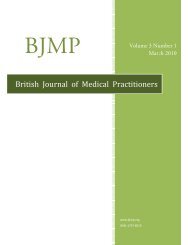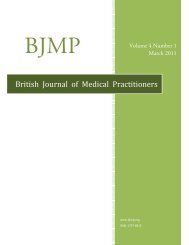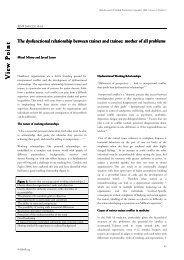R esearch A rticle - British Journal of Medical Practitioners
R esearch A rticle - British Journal of Medical Practitioners
R esearch A rticle - British Journal of Medical Practitioners
Create successful ePaper yourself
Turn your PDF publications into a flip-book with our unique Google optimized e-Paper software.
<strong>British</strong> <strong>Journal</strong> <strong>of</strong> <strong>Medical</strong> <strong>Practitioners</strong>, March 2013, Volume 6, Number 1<br />
psychologically minded and unable to engage in sessions, he<br />
stopped attending.<br />
Discussion<br />
The clinical features in this man were consistent with the<br />
definition <strong>of</strong> PGAD. He had physical arousal symptoms, which<br />
were not related to sexual desire or thoughts and was causing<br />
severe distress to him. The symptoms were relieved by<br />
ejaculation to a certain extent. He was treated with diazepam<br />
and pregabalin which reduced the intensity <strong>of</strong> the symptoms.<br />
There is an emerging literature on the pathophysiology, possible<br />
aetiological factors and the management options <strong>of</strong> PGAD.<br />
There are various associations reported including<br />
psychological 4 , 5 and organic 6-9 pathologies with some<br />
convincing evidence.<br />
In this case, he suffered few UTI and a minor complication <strong>of</strong><br />
painful scrotum following vasectomy, few years before the onset<br />
<strong>of</strong> PGAD. However he had a full urological and neurological<br />
work-up recently which didn’t show any underlying organic<br />
cause for his current symptoms. He suffered no previous<br />
depressive or anxiety disorder. Hence his current symptoms<br />
may be induced by anxiety which is further worsened by the<br />
fact that he became focussed on the genital arousal and<br />
attaining climax to relieve the pain. When he was prescribed<br />
diazepam and pregabalin, his anxiety eased and his physical<br />
symptoms diminished in intensity. However the possibility <strong>of</strong><br />
an organic cause cannot be ruled out completely as he<br />
previously suffered sensory neuropathic pain following<br />
vasectomy. Further pregabalin is useful for both generalised<br />
anxiety and neuropathic pain. Therefore we conclude that his<br />
symptoms may be a result <strong>of</strong> interaction between physical and<br />
psychological factors. This suggests that PGAD could be a<br />
psychosomatic condition, which was already proposed as a<br />
cause for PGAD in women by Goldmeier and Leiblum. 4<br />
Similar to the causes for PGAD, there is few treatment<br />
modalities reported in the literature. These include treatment <strong>of</strong><br />
the underlying organic causes if any found, electro-convulsive<br />
therapy (ECT) if co-morbid with mood<br />
symptoms, 10 transcutaneous electrical nerve stimulation<br />
(TENS), 3 cognitive behavioural therapy 11 and medications like<br />
varenicline. 2 We used anti-anxiety medications (diazepam and<br />
pregabalin) and achieved adequate symptom relief. This also<br />
supports the idea that PGAD could be a psychosomatic<br />
condition related to the peripheral nerves <strong>of</strong> the genito-urinary<br />
system.<br />
This case is reported to confirm that PGAD also<br />
occurs in males, which is quite different from<br />
priapism and it could be a psychosomatic condition.<br />
More r<strong>esearch</strong> is needed into the pathophysiology <strong>of</strong><br />
PGAD and its management.<br />
Competing Interests<br />
None declared<br />
Author Details<br />
RAJKUMAR KAMATCHI, MBBS, DMH, MRCPsych, ST6- General Adult<br />
Psychiatry trainee & Honorary Associate Clinical Teacher, Warwick <strong>Medical</strong><br />
School, The Caludon Centre, Coventry, UK. ANDREW ASHLEY-SMITH,<br />
FRCPsych (SA), MRCPsych, MMedSci, Consultant Psychiatrist & Honorary<br />
Associate Clinical Pr<strong>of</strong>essor, Warwick <strong>Medical</strong> School, The Caludon Centre,<br />
Coventry, UK.<br />
CORRESSPONDENCE: DR RAJKUMAR KAMATCHI, The Caludon Centre,<br />
Coventry, UK, CV2 2TE.<br />
Email: rajkumaranjali@yahoo.com<br />
REFERENCES<br />
1. Goldmeier D, Meau A, Hiller J, Crowley T. Persistent genital arousal<br />
disorder: A review <strong>of</strong> the literature and recommendations for<br />
management. Int J STD AIDS 2009; 20/6:373-77<br />
2. Korda JB, Pfaus JG, Goldstein I. Persistent genital arousal disorder: A<br />
case report in a woman with lifelong PGAD where serendipitous<br />
administrations <strong>of</strong> varenicline tartate resulted in symptomatic<br />
improvement. J Sex Med 2009; 6:1479-86<br />
3. Waldinger MD, Venema PL, van Gils APG, de Lint GJ, Schweitzer<br />
DH. Stronger evidence for small fiber sensory neuropathy in restless<br />
genital syndrome: two case reports in males. J Sex Med 2011; 8:325-30<br />
4. Goldmeier D, Leiblum S. Interaction <strong>of</strong> organic and psychological<br />
factors in PGAD in women. A report <strong>of</strong> six cases. Int J STD AIDS<br />
2008; 19:488-90<br />
5. Leiblum S, Goldmeier D. PGAD in women: case reports <strong>of</strong> association<br />
with antidepressant usage and withdrawal. J Sex Marital Therapy 2008;<br />
34:1150-9<br />
6. Leiblum S, Seehuus M, Goldmeier D, Brown C. Psychological, medical<br />
and pharmacological correlates <strong>of</strong> PGAD. J Sex Med 2007; 4:1358-66<br />
7. Thorne C, Stuckey B. Pelvic congestion syndrome presenting as<br />
persistent genital arousal: A case report. J Sex Med 2008; 5:504-8<br />
8. Battaglia C, Venturoli S. PGAD and trazodone. Morphometric and<br />
vascular modifications <strong>of</strong> the clitoris. A case report. J Sex Med 2009;<br />
6:2896-900<br />
9. Waldinger MD, Venema PL, van Gils APG, Schweitzer DH. New<br />
insights into restless genital syndrome: static mechanical hyperthesia<br />
and neuropathy <strong>of</strong> the nervus dorsalis clitoridis. J Sex Med 2009;<br />
6:2778-87<br />
10. Korda JB, Pfaus JG, Kellner CH, Goldstein I. PGAD: case report <strong>of</strong><br />
long term symptomatic management with ECT. J Sex Med 2009;<br />
6:2901-9<br />
11. Hiller J, Heskster B. Couple’s therapy with cognitive behavioural<br />
techniques for PSAS. Sexual and Relationship Therapy 2007; 22:91-96<br />
BJMP.org<br />
31







